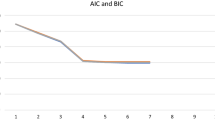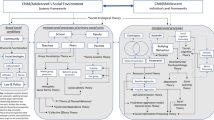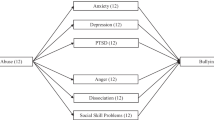Abstract
This study shows longitudinal predictors of involvement in different bullying roles, including mental health, individual, family, peer and school predictors. The analyses were based on a longitudinal prospective study with 916 students followed up from ages 7 to 17 with 7 waves of data. Participants were selected through random sampling and were enrolled in 56 schools. Predictors were measured from ages 7 to 11 and involvement in bullying roles and trajectories from ages 11 to 17. Predictors of bullying perpetration were gender, substance use, truancy, ADHD, moral neutralization, self-control, parental monitoring, corporal punishment, liking school, and bonding with the teacher and classmates. Predictors of victimization were gender, substance use, truancy, internalizing problems, self-control, ADHD, bonding to classmates, and social activities. Predictors of bully/victims were gender, divorced parents, substance use, internalizing problems, ADHD, sensation seeking, moral neutralization, self-control, corporal punishment, parental monitoring, liking school, bonding to classmates, and social activities. Truancy was a risk factor for perpetration mostly in girls; low self-control was a risk factor for perpetration especially in boys. Truant children with high classmates bonding were at high risk of perpetration. Low parental monitoring was a risk factor for perpetration in children who did not like school. Low social activities with peers were a risk factor for victimization in boys and substance use was a risk factor for victimization especially in children with low self-control. High classmates bonding was protective against victimization in non-truant children and against being a bully/victim in children with high sensation seeking. Early interventions focused on risk and protective factors could possibly protect children from bullying.

Similar content being viewed by others
References
Alsaker, F. D., Nägele, C., Valkanover, S., & Hauser, D. (2008). Pathways to victimization and a multisetting intervention: project documentation.
Antoniadou, N., Kokkinos, C. M., & Markos, A. (2016). Possible common correlates between bullying and cyber-bullying among adolescents. Psicología Educativa, 22, 27–38.
Averdijk, M., Müller, B., Eisner, M. P., & Ribeaud, D. (2011). Bullying victimization and later anxiety and depression among pre-adolescents in Switzerland. Journal of Aggression, Conflict and Peace Research, 2, 103–109.
Bacchini, D., Affuso, G., & Trotta, T. (2008). Temperament, ADHD and peer relations among schoolchildren: the mediating role of school bullying. Aggressive Behavior, 34(5), 447–459.
Baldry, A. C., & Farrington, D. P. (2000). Bullies and delinquents: personal characteristics and parental styles. Journal of Community & Applied Social Psychology, 10, 17–31.
Benedini, K. M., Fagan, A. A., & Gibson, C. L. (2016). The cycle of victimization: the relationship between childhood maltreatment and adolescent peer victimization. Child Abuse & Neglect, 59, 111–121.
Bowes, L., Maughan, B., Ball, H., Shakoor, S., Ouellet-Morin, I., Caspi, A., Moffitt, T. E., & Arseneault, L. (2013). Chronic bullying victimization across school transitions: the role of genetic and environmental influences. Development and Psychopathology, 25(2), 333–346.
Brendgen, M., Girard, A., Vitaro, F., Dionne, G., & Boivin, M. (2016). Personal and familial predictors of peer victimization trajectories from primary to secondary school. Developmental Psychology, 52(7), 1103–1114.
Collins, L. M., & Lanza, S. T. (2010). Latent class and latent transition analysis. New Jersey: Wiley.
Cook, C. R., Williams, K. R., Guerra, N. G., Kim, T. E., & Sadek, S. (2010). Predictors of bullying and victimization in childhood and adolescence: a meta-analytic investigation. School Psychology Quarterly, 25(2), 65–83.
Copeland, W. E., Wolke, D., Angold, A., & Costello, E. J. (2013). Adult psychiatric outcomes of bullying and being bullied by peers in childhood and adolescence. JAMA Psychiatry, 70(4), 419–426.
Cross, D., Lester, L., & Barnes, A. (2015). A longitudinal study of the social and emotional predictors and consequences of cyber and traditional bullying victimisation. International Journal of Public Health, 60(2), 207–217.
Del Rey, R., Casas, J. A., & Ruiz, R. O. (2017). The development and validation of the schoolwide climate scale. Universitas Psychologica, 16(1) 1-11.
Durlak, J. A., Weissberg, R. P., Dymnicki, A. B., Taylor, R. D., & Schellinger, K. B. (2011). The impact of enhancing students’ social and emotional learning: a meta-analysis of school-based universal interventions. Child Development, 82(1), 405–432.
Dussich, J. P. J., & Maekoya, C. (2007). Physical child harm and bullying-related behaviors - a comparative study in Japan, South Africa, and the United States. International Journal of Offender Therapy and Comparative Criminology, 51(5), 495–509.
Eisner, M. P., & Malti, T. (2015). Aggressive and violent behavior. In M. E. Lamb (vol. ed.) & R. M. Lerner (Series ed.) (Eds.), Handbook of child psychology and developmental science, Vol. 3: Social, emotional and personality development (pp. 795–884). New York, NY: Wiley.
Eisner, N. L., Murray, A. L., Eisner, M., & Ribeaud, D. (2019). A practical guide to the analysis of non-response and attrition in longitudinal research using a real data example. International Journal of Behavioral Development, 43(1), 24–34.
Espelage, D. L. (2014). Ecological theory: preventing youth bullying, aggression, and victimization. Theory Into Practice, 53(4), 257–264.
Espelage, D. L., Rao, M. A., & De la Rue, L. (2013). Current research on school-based bullying: a social-ecological perspective. Journal of Social Distress and Homeless, 22(1), 7–21.
Fanti, K. A., & Kimonis, E. R. (2013). Dimensions of juvenile psychopathy distinguish “bullies,” “bully-victims,” and “victims”. Psychology of Violence, 3(4), 396–409.
Farrington, D. P., & Ttofi, M. M. (2009). School-based programs to reduce bullying and victimization. Campbell Systematic Reviews, 6.
Farrington, D. P., Ttofi, M. M., Crago, R. V., & Coid, J. W. (2015). Intergenerational similarities in risk factors for offending. Journal of Developmental and Life-Course Criminology, 1, 48–62.
Gaffney, H., Ttofi, M. M., & Farrington, D. P. (2019). Evaluating the effectiveness of school-bullying prevention programs: an updated meta-analytical review. Aggression and Violent Behavior, 45, 111-133.
Gastic, B. (2008). School truancy and the disciplinary problems of bullying victims. Educational Review, 60(4), 391–404.
Gini, G., & Pozzoli, T. (2013). Bullied children and psychosomatic problems: a meta-analysis. Pediatrics, 132(4), 720–729.
Gini, G., Pozzoli, T., & Hymel, S. (2014a). Moral disengagement among children and youth: a meta-analytic review of links to aggressive behavior. Aggressive Behavior, 40(1), 56–68.
Gini, G., Pozzoli, T., Lenzi, M., & Vieno, A. (2014b). Bullying victimization at school and headache: a meta-analysis of observational studies. Headache, 54(6), 976–986.
Gomez-Ortiz, O., Del Rey, R., Casas, J. A., & Ortega-Ruiz, R. (2014). Parenting styles and bullying involvement. Cultura Y Educacion, 26(1), 132–158.
Gomez-Ortiz, O., Romera, E. M., Ortega-Ruiz, R., Herrera, M., & Norman, J. O. (2019). Multidimensional social competence in research on bullying involvement: a cross-cultural study. Behavioral Psychology-Psicologia Conductual, 27(2), 217–238.
Gómez-Ortiz, O., Romera, E. M., & Ortega Ruiz, R. (2017). Multidimensionality of social competence: measurement of the construct and its relationship with bullying roles. Revista de Psicodidáctica, 22, 37–44.
Grasmick, H. G., Tittle, C. R., Bursik, R. J., & Arneklev, B. J. (1993). Testing the core empirical implications of Gottfredson and Hirschi’s general-theory of crime. Journal of Research in Crime and Delinquency, 30(1), 5–29.
Hemphill, S. A., Kotevski, A., Tollit, M., Smith, R., Herrenkohl, T. I., Toumbourou, J. W., & Catalano, R. F. (2012). Longitudinal predictors of cyber and traditional bullying perpetration in Australian secondary school students. Journal of Adolescent Health, 51(1), 59–65.
Holt, M. K., Vivolo-Kantor, A. M., Polanin, J. R., Holland, K. M., DeGue, S., Matjasko, J. L., Wolfe, M., & Reid, G. (2015). Bullying and suicidal ideation and behaviors: a meta-analysis. Pediatrics, 135(2), E496–E509.
Kim, Y. S., Boyce, W. T., Koh, Y. J., & Leventhal, B. L. (2009). Time trends, trajectories, and demographic predictors of bullying: a prospective study in Korean adolescents. Journal of Adolescent Health, 45(4), 360–367.
Klein, D. A., Myhre, K. K., & Ahrendt, D. M. (2013). Bullying among adolescents: a challenge in primary care. American Family Physician, 88(2), 87, 87-92.
Lereya, S. T., Samara, M., & Wolke, D. (2013). Parenting behavior and the risk of becoming a victim and a bully/victim: a meta-analysis study. Child Abuse & Neglect, 37(12), 1091–1108.
Lyznicki, J. M., McCaffree, M. A., & Robinowitz, C. B. (2004). Childhood bullying: implications for physicians. American Family Physician, 70(9), 1723–1728.
Murray, A., Eisner, M., Ribeaud, D., Kaiser, D., McKenzie, K., & Murray, G. (2019). Validation of a brief self-report measure of adolescent bullying perpetration and victimisation: The Zurich Brief Bullying Scales (ZBBS). Assessment, Ahead of print.
Nasaescu, E., Zych, I., Ortega-Ruiz, R., Farrington, D. P., & Llorent, V. J. (2020). Longitudinal patterns of antisocial behaviors in early adolescence: A latent class and latent transition analysis. The European Journal of Psychology Applied to Legal Context. Ahead of print. https://doi.org/10.5093/ejpalc2020a10
Ortega, R., Del Rey, R., & Mora-Merchan, J. A. (2004). SAVE model: an antibullying intervention in Spain. In P. K. Smith, D. Pepler, & K. Rigby (Eds.), Bullying in schools: How successful can interventions be? (pp. 167–186). Cambridge, UK: Cambridge University Press.
Pouwels, J. L., Salmivalli, C., Saarento, S., van den Berg, Y. H., Lansu, T. A., & Cillessen, A. H. (2018). Predicting adolescents’ bullying participation from developmental trajectories of social status and behavior. Child Development, 89(4),1157-1176.
Reijntjes, A., Kamphuis, J. H., Prinzie, P., Boelen, P. A., van der Schoot, M., & Telch, M. J. (2011). Prospective linkages between peer victimization and externalizing problems in children: a meta-analysis. Aggressive Behavior, 37(3), 215–222.
Reijntjes, A., Kamphuis, J. H., Prinzie, P., & Telch, M. J. (2010). Peer victimization and internalizing problems in children: a meta-analysis of longitudinal studies. Child Abuse & Neglect, 34(4), 244–252.
Ribeaud, D., & Eisner, M. (2010a). Are moral disengagement, neutralization techniques, and self-serving cognitive distortions the same? Developing a unified scale of moral neutralization of aggression. International Journal of Conflict and Violence, 4(2), 298–315.
Ribeaud, D., & Eisner, M. (2010b). Risk factors for aggression in pre-adolescence: risk domains, cumulative risk and gender differences - results from a prospective longitudinal study in a multi-ethnic urban sample. European Journal of Criminology, 7(6), 460–498.
Romera, E. M., Casas, J. A., Gomez-Ortiz, O., & Ortega-Ruiz, R. (2019). Moral domain as a risk and protective factor against bullying. An integrating perspective review on the complexity of morality. Aggression and Violent Behavior, 45, 75–82.
Schafer, M., Korn, S., Brodbeck, F. C., Wolke, D., & Schulz, H. (2005). Bullying roles in changing contexts: the stability of victim and bully roles from primary to secondary school. International Journal of Behavioral Development, 29(4), 323–335.
Shelton, K. K., Frick, P. J., & Wootton, J. (1996). Assessment of parenting practices in families of elementary school-age children. Journal of Clinical Child Psychology, 25(3), 317–329.
Shetgiri, R., Espelage, D. L., & Carroll, L. (2015). Practical strategies for clinical management of bullying. New York: Springer.
Smith, P. K., & Brain, P. (2000). Bullying in schools: lessons from two decades of research. Aggressive Behavior, 26(1), 1–9.
Solberg, M. E., & Olweus, D. (2003). Prevalence estimation of school bullying with the Olweus Bully Victim Questionnaire. Aggressive Behavior, 29(3), 239–268.
Sourander, A., Gyllenberg, D., Klomek, A. B., Sillanmaki, L., Ilola, A. M., & Kumpulainen, K. (2016). Association of bullying behavior at 8 years of age and use of specialized services for psychiatric disorders by 29 years of age. JAMA Psychiatry, 73(2), 159–165.
Sourander, A., Helstela, L., Helenius, H., & Piha, J. (2000). Persistence of bullying from childhood to adolescence - a longitudinal 8-year follow-up study. Child Abuse & Neglect, 24(7), 873–881.
Swearer, S. M., & Cary, P. T. (2003). Perceptions and attitudes toward bullying in middle school youth: a developmental examination across the bully/victim continuum. Journal of Applied School Psychology, 19, 63–79.
Tremblay, R. E., Loeber, R., Gagnon, C., Charlebois, P., Larivee, S., & Leblanc, M. (1991). Disruptive boys with stable and unstable high fighting behavior patterns during junior elementary-school. Journal of Abnormal Child Psychology, 19(3), 285–300.
Ttofi, M. M., Farrington, D. P., Losel, F., Crago, R. V., & Theodorakis, N. (2016). School bullying and drug use later in life: a meta-analytic investigation. School Psychology Quarterly, 31(1), 8–27.
Ttofi, M. M., Farrington, D. P., Losel, F., & Loeber, R. (2011a). The predictive efficiency of school bullying versus later offending: a systematic/meta-analytic review of longitudinal studies. Criminal Behaviour and Mental Health, 21(2), 80–89.
Ttofi, M. M., Farrington, D. P., Lösel, F., & Loeber, R. (2011b). Do the victims of school bullies tend to become depressed later in life? A systematic review and meta-analysis of longitudinal studies. Journal of Aggression, Conflict and Peace Research, 3, 63–73.
Unnever, J. D., & Cornell, D. G. (2003). Bullying, self-control, and ADHD. Journal of Interpersonal Violence, 18(2), 129–147.
Valdebenito, S., Ttofi, M., & Eisner, M. (2015). Prevalence rates of drug use among school bullies and victims: a systematic review and meta-analysis of cross-sectional studies. Aggression and Violent Behavior, 23, 137–146.
Valdebenito, S., Ttofi, M. M., Eisner, M. P., & Gaffney, H. (2017). Weapon carrying in and out of school among pure bullies, pure victims and bully-victims: a systematic review and meta-analysis of cross-sectional and longitudinal studies. Aggression and Violent Behavior, 33, 62–77.
Young, S., Moss, D., Sedgwick, O., Fridman, M., & Hodgkins, P. (2015). A meta-analysis of the prevalence of attention deficit hyperactivity disorder in incarcerated populations. Psychological Medicine, 45(2), 247–258.
Zych, I., Farrington, D. P., & Ttofi, M. M. (2019). Protective factors against bullying and cyberbullying: a systematic review of meta-analyses. Aggression and Violent Behavior, 45, 4–19.
Zych, I., Ortega-Ruiz, R., & Del Rey, R. (2015). Systematic review of theoretical studies on bullying and cyberbullying: facts, knowledge, prevention, and intervention. Aggression and Violent Behavior, 23, 1–21.
Zych, I., Ttofi, M. M., Farrington, D. P., Ribeaud, D., & Eisner, M. P. (2020). A longitudinal study on stability and transitions among bullying roles. Child Development, 91(2), 527-545
Acknowledgments
We are grateful to the youths, parents, and teachers who provided data for the z-proso study.
Funding
The authors received financial support from the Swiss National Science Foundation, the Jacobs Foundation, and the Swiss Federal Office of Public Health for the z-proso study during the period 2009–2015.
Author information
Authors and Affiliations
Corresponding author
Ethics declarations
Conflict of Interest
The authors declare that they have no conflict of interest.
Rights and permissions
About this article
Cite this article
Zych, I., Farrington, D.P., Llorent, V.J. et al. Childhood Risk and Protective Factors as Predictors of Adolescent Bullying Roles. Int Journal of Bullying Prevention 3, 138–146 (2021). https://doi.org/10.1007/s42380-020-00068-1
Published:
Issue Date:
DOI: https://doi.org/10.1007/s42380-020-00068-1




